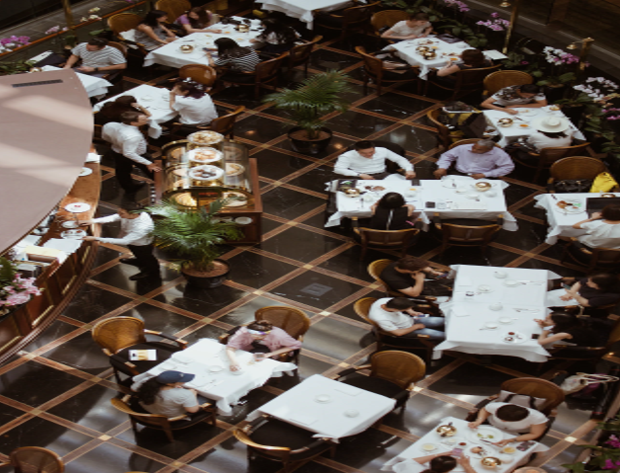Running a successful restaurant in the 21st century is no easy feat. In fact, countless restaurants struggle to make it past their first few years. Many establishments are forced to consider shutting down within 12 to 24 months because they can’t make ends meet. Believe it or not, but the issue has got nothing to do with cooking quality. More often than not, those restaurants have carefully selected their location and have recruited a team of trained cooks. In other words, they didn’t come unprepared. And yet, it wasn’t enough to make it work.
Modern challenges, such as rising competition from delivery places, changing consumer preferences, and increasing operational costs make it tough for new restaurants to survive. It is getting increasingly difficult for restaurants in 2023 to remain an attractive place, both for customers and employees. Customers are less likely to go to restaurants: Many prefer to order from apps such as Just Eat or Uber Eats because it is more convenient. With a low footfall, it is normal that employees are looking to switch places and protect their income. But unfortunately, this can make it tough for restaurants to overcome the obstacles.
But that is precisely where integrating technology as part of their business strategy can make a huge difference. In this article, we’ll explore the many ways leveraging technology can improve revenues, focusing on 3 key aspects:
- Productivity
- Virality
- Transaction
Productivity
In an industry where time and precision are of the essence, it makes no doubt that increasing productivity can significantly affect the success of any restaurant. Despite the business’s best efforts to stay on top of operations, restaurant owners and managers can struggle without appropriate tech solutions that can do all the hard work for them. Here is how embracing technology can streamline your operations.
Staff and shift scheduling
Effective shift scheduling plays a pivotal role in optimizing productivity, regardless of your business sector. Indeed, ensuring you’ve got the appropriate number of staff on site to handle the different volumes of demands is absolutely essential. The last thing any restaurant needs is to be overstaffed during quiet hours or short-staffed during peak hours. Yet, manual scheduling can be time-demanding and tricky to coordinate. In small restaurants, managers are often forced to call staff unexpectedly and ask them to come and help during busy services.
As such, scheduling tools can enable restaurant managers to not only efficiently allocate staff members, but also mark peak hours for appropriate coverage. This will prevent under- and overstaffing. If you are considering investing in a tool, you can find a list of the best restaurant scheduling apps here. They allow you to not only schedule service times, but also manage holidays, and easily get employees to pick shifts when needed.
The future of restaurant staffing is digital when it comes to effective productivity management.
Insights into most popular dishes
This may seem like basic restaurant knowledge, but countless establishments fail to harness the power of data. Basic customer data will reveal which dishes are most commonly ordered in the restaurant. But, there are also handy tech solutions that give restaurants further insights into their most popular dishes.
Something as simple as monitoring social media content and actively taking control of the content by sharing your own photos can help increase the popularity of some of your dishes. Additionally, a foodspotting app or a best restaurants directory can also become a practical tool for restaurants. Indeed, monitoring online activities, via social media and via specialist content, can help identify customer favorites and understand their preferences better. Armed with this knowledge, chefs and managers can not only optimize their menus, but also their supplies and kitchen processes. As a result, restaurants can hope to streamline kitchen operations and enhance customer satisfaction. This will ultimately drive repeat businesses and boost revenues.
Virality
We’ve just mentioned social media. In today’s digitally connected world, social media is often at the center of business growth. Indeed, social media plays a huge role in shaping and influencing consumer behavior nowadays. A viral post could drive footfall! More importantly, a viral post for restaurants doesn’t need to reach millions of social media users. In fact, restaurants are a local business, as such going viral locally is more achievable! Harnessing the power of social media can increase your visibility and attract new customers.
Wireless phone chargers at tables
By providing wireless phone chargers in the dining area, restaurants can actively encourage customers to use their phones. It is best to consider chargers that will be compatible with both Android and iPhone devices.
Customers can then be more likely to engage in social media activities. You can also add a tagline by each charging spot, such as “Share your experience @XXX where XXX is your restaurant’s social media name on specific platforms”. Customers can capture and share their photos of the dining experience. This user generated content can act as powerful word-of-mouth marketing that will encourage others to visit.

Branded photo or video filters
Photo or video filters are popular on platforms such as Tiktok and Snapchat. While many restaurants prefer to focus on visual platforms, such as Instagram or Facebook, the digital conversation potential for filters is not to be ignored. Creating a unique filter that reflects your restaurant’s brand can help attract the attention of many users, local or not.
What is a good filter for a restaurant?
- You can share a short video of a chef cooking and let users place their faces in the animation.
- You can let users pass an order and eat it, as some TikTok filters are interactive.
- You can create a background with a stunning photo of your dining area.
Filters not only drive engagement and interactions, but they also foster a sense of connection with your brand. As users create and share content with your filter, it instantly generate buzz for your restaurant.
Live kitchen video feed
Displaying an overhead video feed of the kitchen in the dining area allows customers to watch as their dish is being prepared. This can be beneficial for many reasons. Firstly, the element of transparency can help build a reputation for high quality. Secondly, this can also create a sense of excitement.
Besides, customers are likely to capture and share these live kitchen feeds on social media, which will not only drive more exposure but also bring a viral potential. This can be an innovative use of technology to drive revenues and enhance customer loyalty and engagement.
Transaction
The payment process is, of course, an essential aspect of running a successful restaurant. The pandemic has driven small places to add card payments to their systems, which is highly beneficial to their customers. But there are many more choices you can make to streamline the payment process and make ordering easier.
Multiple payment solutions
What is the most popular way of paying in a restaurant? Depending on your target audience, this may be credit card or cash. But, mobile phone payments, such as Apple Pay and Google Pay, are growing in popularity. Contactless payment solutions are high in demand. As such, if you haven’t yet included mobile payment options, it is time to address the gap! Essentially, if customers know from the start they can pay with their preferred method, they are more likely to order freely, rather than limit themselves to stick to a specific amount.
Order online solutions from the table
You’ve probably come across the QR code order menu during the pandemic, empowering customers to eat out while limiting contact. There is no reason to remove the QR menu and order solutions from your restaurant. Many customers prefer to reduce human interactions during the ordering process, either because they are not confident English speakers, such as tourists, or because they are shy or introverted. This can make it easier for them to order, and even filter your menu by ingredients or dietary requirements.
The other advantage of the online ordering system is that customers order and pay directly via an online platform, which means the restaurant collects payments immediately.
In an era where technology has a transformative role in most industry sectors, it makes sense for restaurants to embrace the solutions available.
Related Posts













One thought on “How Restaurants Can (And Should) Harness Technology To Enhance Revenues”
Comments are closed.